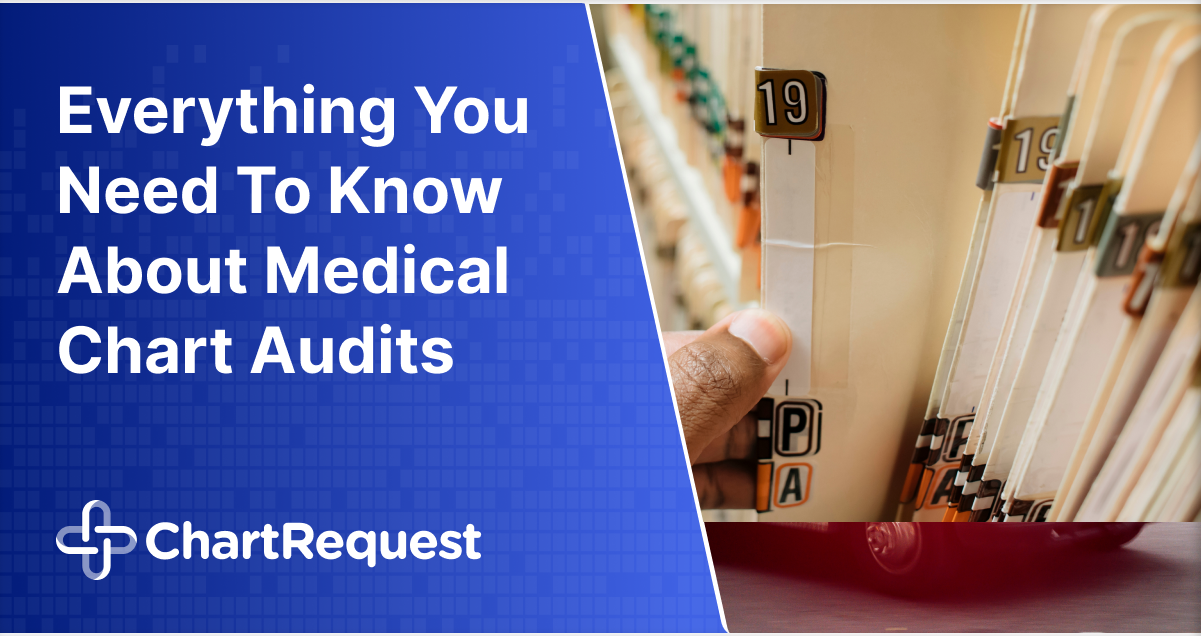Is your organization prepared for its next medical chart audit? These systematic reviews are integral to the healthcare industry, encouraging providers to record accurate data and deliver quality care.
The more records you store, the more complex and necessary these audits become. Still, preparing for medical chart reviews in 2025 shouldn’t feel overwhelming.
In this article, we’ll discuss the ins and outs of medical chart audits to help you develop a successful strategy. If you need help with an urgent or upcoming audit, find out how we may be able to help.
Understanding Medical Charts and Access Rights
Medical charts contain a comprehensive record of every health-related event a patient experiences in their lifetime. These detailed documents help physicians and insurance providers understand patient conditions and develop appropriate treatment plans.
Here are several items you may find on the average medical chart:
- Surgery dates and annotations
- Pregnancy details
- Active and past medication use
- Reported allergies
- Family medical history
- History of drug and alcohol use
- Physical and mental developmental history
- Personal details (age, sex, ethnicity, and contact information)
- Dates of past medical appointments
Patients have the right to access and review their medical charts at any time, so your organization should keep patient records secure and up to date. Additionally, the federal government, attorneys, and insurance companies, and other requestors may submit requests for patient records.

What Is a Medical Chart Audit?
A medical chart audit (or health record review) is when an authorized individual, medical auditor, or group examines patient records for accuracy, completeness, and quality. Physical and electronic documents are both subject to formal examinations.
Audits inspect documents for:
- Drug coding accuracy
- Appropriate billing information
- Compliance with regulatory and accreditation standards
- Quality of care rendered to the patient
- Applicable research data
Reputable organizations undergo health record reviews at least four times a year. This way, they have all the information they need to identify areas of improvement and enhance overall patient safety. These routine chart audits prevent compliance-related errors that may result in steep fines or other penalties.
Why Are Medical Chart Audits Necessary?
Medical chart reviews can uncover discrepancies in your organization’s operations or patient accountability standards. However, it’s important to understand that no two audits are identical.
Your healthcare organization should prepare to respond to multiple audits throughout the year. These reviews serve multiple purposes, including:
- Required Measuring: The Healthcare Effectiveness Data and Information Set (HEDIS) provides the standard metric for performance in the healthcare industry. Laws and regulations generally require health insurance companies to report their status at least once a year. Employers and those seeking new insurance benefits can use accurate data from these reviews to compare health plans.
- Administrative Standardization: Federal regulations require medical charts to justify charges coded and billed for in healthcare settings. Audits measure compliance and provide detailed information to protect patients from overbilled services.
- Research: Some medical records contain data useful to clinical research. For example, auditors may review records from numerous facilities to measure the pervasiveness of certain diseases. Research applications may also be operational, giving auditors a gauge to measure strengths and weaknesses.
Types of Audits To Know
Medical chart audits vary depending on the organization’s objective, scope, and deployment method. Understanding each type of probe can help your facility fine-tune its internal processes and reporting systems for optimal results.
Here are the common categories of audits your healthcare company may receive:
- Compliance Audits: These audits verify adherence to various regulatory, accreditation, and institutional standards. They aim to prevent fraud and waste within the healthcare system.
- Clinical Audits: Also known as quality improvement audits, assess the quality and effectiveness of the care provided to patients. Clinical audits can also identify areas for improvement related to patient comfort and privacy.
- Risk Management Audits: These audits identify potential risks in the delivery of healthcare services. The goal is to enhance patient safety and minimize any legal or financial risks associated with patient care. Failing these audits may indicate that your practice needs to improve training, facility sanitation, or other elements that directly affect the patient experience.
Now, let’s look at some specific audits that may require you to release medical charts.
Recovery Audit Contractors (RAC)
RAC is a third-party contractor representing the Centers for Medicare and Medicaid Services (CMS). It collects data from complex and automated post-payment reviews and then reports its findings to the federal government.
These audits ensure the accuracy of medical coding and billing. In other words, they help prevent the over or underbilling of specific services.
Medicare Administrative Contractors (MAC)
MAC is a healthcare insurer tasked with overseeing the processing and verification of Medicare Part A and Part B claims. They also process Durable Medical Equipment claims for Fee-For-Service (FFS) members.
MAC conducts routine medical chart audits. However, the organization may deploy frequent or targeted audits on healthcare providers if they receive multiple complaints regarding billing. Some audits may not result in corrective action, while others require significant mitigation.
The Healthcare Effectiveness Data and Information Set (HEDIS)
HEDIS provides one of the most comprehensive audits in the healthcare industry. According to the Department of Health and Human Services, over 90% of healthcare providers rely on this tool to measure the performance and impact of medical services.
HEDIS covers an extensive range of health concerns, including but not limited to:
- Effect of asthma drugs and treatment
- Beta-blocker treatment after a cardiac arrest
- High blood pressure treatment
- Diabetes care
- Mammograms
- STI screenings
- Antidepressant medication
- Vaccine immunization
- Tobacco cessation
Medicare Advantage Risk Adjustment Data Validation (RADV)
CMS uses the Medicare Advantage Risk Adjustment Data Validation program to address overpayment errors in Medicare Advantage Organizations. During these comprehensive audits, CMS verifies that all diagnoses submitted by an organization for risk adjustments are consistent with the enrollee’s medical record.
RADV audits ensure the organization receives accurate payments and reimbursements corresponding to its registered beneficiaries’ health and demographic characteristics.
Which Type of Audit Should Your Organization Expect?
The type of audit you can expect depends on the nature of your healthcare organization and the specific areas of focus within your facility.
For instance, hospitals and clinics often undergo compliance and clinical audits (HEDIS/RADV). In contrast, medical billing companies frequently face billing and coding audits (RAC/MAC). You should prepare for each audit type, including the new Security Rule audits.
Regular internal audits can help identify and rectify potential issues before an official audit takes place — ensuring that your organization always stays one step ahead.
The Risks of In-Person Health Record Reviews
In-person medical chart audits can be risky for a few reasons. For example, quality control is a common concern during these examinations. When an auditor conducts a review on your behalf, you may be unable to filter misfiles or ensure that the auditor only takes the necessary information.
Remember: Release of information violation liability falls on the organization, not the auditor.
How To Prepare For Medical Chart Audits
Preparing for a medical chart audit may seem daunting. However, your healthcare organization can ensure a smooth chart review process with careful planning and execution.
Let’s explore several tips to streamline your audit without stress:
Understand Your Audit Scope
Understanding the scope of your audit is the first step toward a successful review. This involves knowing what your auditor will look for, the standards they will judge against (like HEDIS), and the timeframe the audit will cover.
For example, ask yourself:
- Will the review process take several days or weeks?
- What were the results of your last audit?
- Did you adjust your procedures to achieve better outcomes?
Know Your Auditor
Find out more about your auditor. What is their background? What kind of audits do they conduct for other healthcare organizations?
Understanding the auditor’s perspective can help you anticipate their expectations and prepare accordingly.
You may not always know which medical auditor you have until they start requesting records, but you can plan your operations to accommodate auditors of all different backgrounds and experience levels.
Review Previous Audit Reports
Reviewing previous audits can give you valuable insights into the areas that need improvement.
Paying attention to recurrent issues can help you prioritize your efforts and demonstrate a commitment to continuous improvement. Your auditor may take such improvements into account during the final scoring process.
Looking over past audits can also help you develop new office policies for documenting, storing, and transferring medical records more efficiently. This way, you can create standards that closely align with future audit requirements.
Plan Your Resources
Allocate sufficient resources for the audit process well in advance, such as time, personnel, and technology.
An audit can be a complex and time-consuming process. Having adequate resources in place can ensure its smooth execution.
Maintain Open Communication
Promote open and transparent communication within your team.
Everyone involved in patient care and billing should understand the importance of accurate and complete documentation. Regular training sessions can keep your team current on the latest best practices, coding changes, and regulatory requirements.
Comprehensive training will also reduce the risk of accidental information disclosures that violate HIPAA privacy rules.
Conduct Regular Internal Audits
You may conduct routine internal audits to comply with your organization’s quality assurance policies. Regularly checking your records can help identify potential issues before an official review.
Internal audits should reflect the process of an external health audit, reviewing both the quality of care and the accuracy of coding and billing.
Store Accurate Documentation
Accurate PHI record-keeping is essential in healthcare. You should document all patient information (including care procedures, tests, and treatments) to prevent confusion or discrepancies during the chart audit process.
A clear and concise medical record can significantly simplify your reviews and improve patient trust.
Rinse and Repeat
The goal of a medical chart audit isn’t just to “pass the test.” It is an opportunity for your organization to enhance its operations, prevent fraudulent practices, and ensure appropriate compensation for services rendered.
By treating audits as an ongoing improvement process rather than a one-time event, your practice can leverage them to drive continuous growth and improvement.
Simplify Your Future Medical Chart Audits
Medical chart audits can be overwhelming for healthcare professionals. From the stress of being judged under a microscope to the administrative workload of fulfilling audit requests, it can be difficult to manage it alone.
ChartRequest is a release of information solution purpose-built to support healthcare organizations with all record exchange needs. From bulk audit record requests to care coordination, we can help your practice thrive.
Don’t let medical chart audits intimidate you. Schedule a no-cost consultation to learn how we can ease the pressure of your future audits


